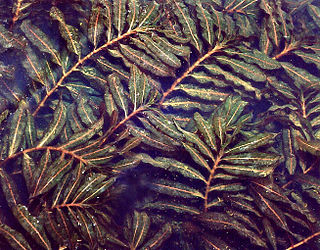| Potamogeton clystocarpus | |
|---|---|
| Scientific classification | |
| Kingdom: | Plantae |
| Clade: | Angiosperms |
| Clade: | Monocots |
| Order: | Alismatales |
| Family: | Potamogetonaceae |
| Genus: | Potamogeton |
| Species: | P. clystocarpus |
| Binomial name | |
| Potamogeton clystocarpus | |
Potamogeton clystocarpus is a rare species of flowering plant in the pondweed family known by the common name Little Aguja pondweed. It is endemic to Texas in the United States, where it is known only from one river canyon in Jeff Davis County. There is a single population of the aquatic plant in Little Aguja Creek, and it has never been seen anywhere else. This is a federally listed endangered species of the United States.

The Potamogetonaceae, commonly referred to as the pondweed family, are an aquatic family of monocotyledonous flowering plants. The roughly 110 known species are divided over six genera. The largest genus in the family by far is Potamogeton, which contains about 100 species.

Endemism is the ecological state of a species being unique to a defined geographic location, such as an island, nation, country or other defined zone, or habitat type; organisms that are indigenous to a place are not endemic to it if they are also found elsewhere. The extreme opposite of endemism is cosmopolitan distribution. An alternative term for a species that is endemic is precinctive, which applies to species that are restricted to a defined geographical area.

Texas is the second largest state in the United States by both area and population. Geographically located in the South Central region of the country, Texas shares borders with the U.S. states of Louisiana to the east, Arkansas to the northeast, Oklahoma to the north, New Mexico to the west, and the Mexican states of Chihuahua, Coahuila, Nuevo León, and Tamaulipas to the southwest, while the Gulf of Mexico is to the southeast.
This aquatic plant has a stem growing up to 57 centimeters long, [1] varying in length depending on the depth of the water. [2] The delicate, spirally arranged leaves are linear in shape and up to 7.8 centimeters in length by 1 or 2 millimeters wide. The inflorescence is the only part of the plant that is not submersed. It arises a few centimeters above the water's surface. [1] The plant reproduces sexually via seed and vegetatively via broken-off fragments of the stem, which can produce roots and anchor to form a new plant. Little else is known about the plant's life history. [3]

An inflorescence is a group or cluster of flowers arranged on a stem that is composed of a main branch or a complicated arrangement of branches. Morphologically, it is the modified part of the shoot of seed plants where flowers are formed. The modifications can involve the length and the nature of the internodes and the phyllotaxis, as well as variations in the proportions, compressions, swellings, adnations, connations and reduction of main and secondary axes. Inflorescence can also be defined as the reproductive portion of a plant that bears a cluster of flowers in a specific pattern.

Sexual reproduction is a type of life cycle where generations alternate between cells with a single set of chromosomes (haploid) and cells with a double set of chromosomes (diploid). Sexual reproduction is by far the most common life cycle in eukaryotes, for example animals and plants.

Vegetative reproduction is any form of asexual reproduction occurring in plants in which a new plant grows from a fragment of the parent plant or a specialized reproductive structure.
The plant has been noted and collected several times since its first collection in 1931. Though extremely restricted in distribution, it has usually appeared common to abundant in the one stream where it occurs. The Little Aguja Creek drains the Davis Mountains of West Texas. [3] It is a very dynamic river, experiencing low levels during drought, severe, scouring flooding during high-drainage seasons, and changing water quality from chemical contamination and livestock upriver. [4]

The Davis Mountains, originally known as Limpia Mountains, are a range of mountains in West Texas, located near Fort Davis, after which they are named. The fort was named for then United States Secretary of War and later Confederate President Jefferson Davis. They are a popular site for camping and hiking and the region includes Fort Davis National Historic Site and Davis Mountains State Park. The historical and architectural value of the fort, along with the rugged natural environment of the park are a significant destination for tourism in Texas.

West Texas is a loosely defined part of the U.S. state of Texas, generally encompassing the arid and semiarid lands west of a line drawn between the cities of Wichita Falls, Abilene, and Del Rio.

A drought or drouth is a natural disaster of below-average precipitation in a given region, resulting in prolonged shortages in the water supply, whether atmospheric, surface water or ground water. A drought can last for months or years, or may be declared after as few as 15 days. It can have a substantial impact on the ecosystem and agriculture of the affected region and harm to the local economy. Annual dry seasons in the tropics significantly increase the chances of a drought developing and subsequent bush fires. Periods of heat can significantly worsen drought conditions by hastening evaporation of water vapour.
In 1991 and 1992 heavy flooding scoured the canyon and the plant has not been seen since. [4] Surveys have not relocated the plant. [2] [3]


















